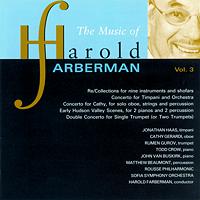
Warmly recommended
The music of
Harold Farberman -
reviewed by
CARSON COOMAN'The performances, all directed by the composer, are strong and authoritative.'
|

|
American composer Harold Farberman (born 1929) has been best known throughout his musical career as a conductor. In recent years, Farberman has received acclaim for the summer 'Conductor's Institute' which he directs -- first for many years at the Hartt School and now at Bard College. During his own conducting career, he served as music director of the orchestras of Colorado Springs, Colorado, USA, and Oakland, California, USA and also as the principal guest conductor of the Denver (Colorado) Symphony and the Bournemouth Sinfonietta, UK.
Farberman began composing in the 1950s while still a student. After Aaron Copland heard his first composition in 1955, he invited Farberman to study with him at Tanglewood. Throughout his compositional career, Farberman has been a strong advocate for the active and engaged use of percussion in contemporary music -- not just as decoration, but as an equally important orchestral section.
This disc is the third release in Albany Records' ongoing series featuring Farberman's compositions, and is by far the most appealing one. Unlike the other two volumes, all of the works (except for one) date from between 2001 and 2003.
The first work, Re/Collections, was commissioned by the Jewish Museum in New York City for their 100th anniversary celebrations in 2004. It is scored for shofar, klezmer clarinet, violin and an ensemble of brass, percussion, and off-stage shofars. Taking as its musical starting point the specifically 'Jewish' connotations in the sounds of the shofar and the klezmer instruments in contrast with the brass and percussion, the work is a celebratory fanfare, that avoids descending into 'ethnic' musical clichés.
Concerto for Timpani and Orchestra was originally composed in 1960 and heavily revised and re-written in 2002. In addition to 'standard' timpani playing, Farberman calls for the soloist to use extended techniques including the use of objects place on the drum heads. It is an exciting work that reveals Farberman's full understanding and love for the solo instrument. (Farberman was a percussionist with the Boston Symphony Orchestra beginning in 1951.) Throughout, the solo timpanist is highlighted by active use of the orchestral percussion
[listen -- track 2, 10:15-11:30].
Continue >>
Copyright © 2 February 2005
Carson P Cooman, Rochester, NY, USA

|

